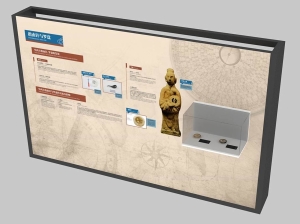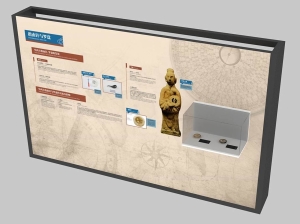在大海上航行,除了要知道位置,还要知道航行的方向,这个时候就要用到我国的四大发明之一,指南针了。我国最早的指南针,叫做“司南”,司机的“司”,南方的“南”,在春秋战国时期就有了。简单说,它就是一个磁石做成的勺子,放在光滑的底板上,勺柄会自动指向南方。
When sailing on the sea, we need to know not only our location but also our direction, which led to the invention of the compass, one of China’s four great inventions. The earliest compass in China appeared during the Spring and Autumn Period and the Warring States Period and was called Sinan. In simple terms, Sinan is a spoon made of a magnet and can automatically point south with its spoon handle when placed on a smooth plate.
到了北宋时期,随着海洋贸易的兴盛,中国人就率先使用指南针来航海远行了。南宋时,中国的航海活动很多,指南工具需要更加精确,于是,出现了带有方位刻度的指南针——罗盘。元代中国船只上用的罗盘,都是“水罗盘”,也就是磁针在水中的罗盘,把磁针直接放在水里,或者借助木片,让指南针浮在水面。大约公元13世纪,阿拉伯人在与中国的海上贸易中学会了使用罗盘,此后罗盘在欧洲普遍应用,极大地促进了世界范围内航海事业的发展。
By the Northern Song Dynasty, driven by a flourishing marine trade, China pioneered utilizing the compass on the seas. During the Southern Song Dynasty, China’s nautical activities increased and required more accurate navigation instruments. Thus, a compass with an azimuth scale called the Luopan was invented. In the Yuan Dynasty, Chinese ships adopted the Shuiluopan, a compass with a magnetic needle worked in water. To use it, you need to place its magnetic needle directly into the water, or float it in water with aid of a piece of wood. Around the 13th century, the Arabs learned of the compass from maritime trade with China. Later, the compass was popularized in Europe, significantly promoting the maritime industry’s development worldwide.
大海航行,有了方向还不够,还要能够计时。
To sail on the sea, only knowing your direction is not enough. You also need a stopwatch.
最早,中西方航海的都以“天”为单位计时,这种计时还不够精确。所以,到了明代,我们又用香来计时,就是一炷香的香。一炷香的时间,大概就是一个时辰,也就是两个小时。而西方也开始采用沙漏来计时。到18世纪,西方发明了航海钟,航海钟不仅可以计时,还可以根据当地时间和零度经线时间的差异,来推算当地的经度,使得航海更加安全可靠。
In the early days, both Chinese and European voyages were timed by days, which was not accurate enough. In the Ming Dynasty, China started applying incense to time calculation while Europe turned to the hourglass for timing. The time to burn one incense stick is about two hours. By the 18th century, the navigation clock was invented in Europe, which not only kept time, but also calculated the local longitude based on the difference between the local time and zero meridian time, making navigation safer and more reliable.
最后,在左边的展板上您还能看到一些著名的导航灯塔。灯塔也是重要的导航工具,在古代,最重要的两座灯塔,泉州的六胜塔和亚历山大灯塔。他们分别位于东方第一大港口——泉州,和西方第一大港口亚历山大城。当年,马可波罗从中国回意大利的时候,就是从六胜塔所在的泉州港出发的。
At last, we can see some famous lighthouses in the left panel. The lighthouse also played a vital role in navigation. The two most well-known lighthouses in ancient times were the Liusheng Lighthouse, located in Quanzhou, the largest port in the East and the Lighthouse of Alexandria, the largest port in the West. Marco Polo, on his return to Italy from China, set out from Quanzhou Port where the Liusheng Lighthouse is located.
马可波罗回到欧洲之后一百多年,在明朝初年,发生了中国古代规模最大的航海事件——郑和下西洋。接下里,请您看看本展区中间的模型。
More than a century after Marco Polo returned to Europe, in the early Ming Dynasty, the biggest sailing event in ancient China was the Grand Voyages of Zheng He. Next, let’s take a look at the model in the middle of this exhibition area.




















 京公网安备11010502039775号
京公网安备11010502039775号





